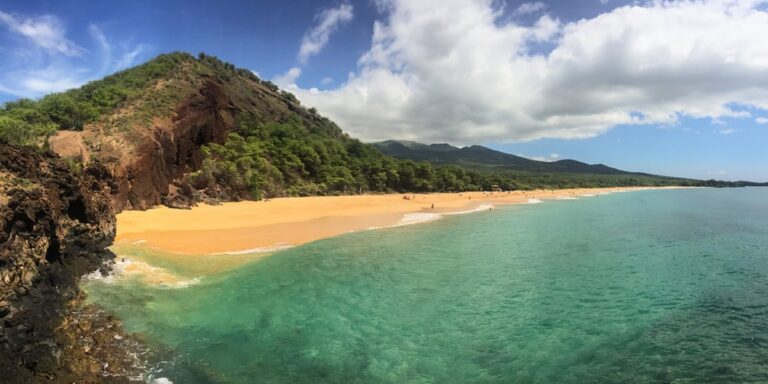Planning a trip to Maui? Well, you’ve come to the right place. While this tropical paradise is a dream destination for many, it’s important to be aware of the worst times to visit to make the most of your vacation. From crowded beaches to scorching temperatures, we’ll guide you through the months to avoid, ensuring you have the best possible experience in Maui.
Weather Conditions
Despite being a tropical paradise, visiting Maui during the rainy season might dampen your beach adventures.
Rainy Season
The months of November to March mark the rainy season in Maui. During this time, the island experiences increased rainfall which can potentially affect outdoor activities and beach enjoyment. While the occasional rain shower can be refreshing, frequent downpours may limit the opportunities for various water-based activities such as snorkeling, surfing, or simply sunbathing on the beach. It is advisable to check weather forecasts before planning outdoor excursions and to pack appropriate rain gear, just in case. However, it’s important to note that even during the rainy season, Maui still offers breathtaking natural beauty and a plethora of indoor attractions to explore.
Crowd Levels
When planning a trip to Maui, it’s important to take into account the crowd levels throughout the year. Certain times of the year experience higher tourist traffic, resulting in longer queues and crowded attractions. By knowing when the peak season occurs, you can better plan your vacation and avoid the masses of people.
Peak Season
Avoiding Maui during the peak season, which typically falls between December and February, can make a significant difference in your overall experience. During this time, the island receives an influx of tourists, leading to crowded beaches, packed restaurants, and busy tourist attractions. By choosing a different time to visit, you can escape the larger crowds and enjoy a more peaceful and authentic experience.
Prices and Accommodation
When planning a trip to Maui, it’s important to be mindful of busy periods as they often come with higher prices for flights, accommodations, and activities. Traveling during peak seasons can significantly impact your budget, so it’s worth considering alternative times to visit.
Holiday Periods
Avoiding travel around major holidays like Christmas and New Year’s is highly recommended. During these festive seasons, prices for both accommodation and flights tend to skyrocket. This surge in demand can make it difficult to find affordable options, and you may end up paying a premium for your stay in Maui. To ensure you get the most value for your money, it’s advisable to plan your visit during less busy periods.
Whale-Watching Season
Maui is renowned for its whale-watching opportunities, attracting visitors from all over the world. However, if you want to increase your chances of spotting these magnificent creatures, it’s important to plan your trip during the peak whale-watching season.
Off-Peak Months
The off-peak months in Maui, when whale sightings are relatively rare, fall outside the period from December to April. If you visit during these months, you may be disappointed with limited or no whale encounters. To make the most of your whale-watching adventure, it is advisable to schedule your trip between December and April.
During these months, humpback whales migrate to the warm waters of Maui from Alaska, giving birth and mating. This migration period offers a unique opportunity to witness these amazing creatures in their natural habitat. The calm waters and gentle climate make Maui the ideal destination for whale-watching during this time.
By planning your visit during the peak whale-watching season, you can enjoy breathtaking sightings of humpback whales breaching, tail-slapping, and engaging in other captivating behaviors. Booking a guided tour with experienced marine experts will enhance your chances of getting up close and personal with these awe-inspiring animals.
While visiting Maui at any time of the year is an incredible experience, timing your trip during the peak whale-watching season guarantees an unforgettable encounter with nature’s giants. So mark your calendar, pack your binoculars, and get ready to be mesmerized by the spectacular display of the humpback whales in Maui!
Conclusion
In conclusion, by taking into account factors such as weather, crowd levels, prices, and whale-watching opportunities, you can avoid the worst times to visit Maui. Planning your vacation during the optimal season when the weather is mild and the crowds are fewer will enhance your overall experience. Additionally, being mindful of budget-friendly periods and considering the whale-watching season will ensure a memorable and enjoyable trip to this tropical paradise. Don’t let the potential drawbacks deter you from experiencing the beauty and enchantment of Maui at its best!
In conclusion, it is important for visitors to Maui to carefully consider the timing of their trip in order to ensure an unforgettable experience. While there may be certain times of the year that are more popular or convenient, it is crucial to be aware of the potential pitfalls that could diminish your overall enjoyment. By avoiding the worst time to visit Maui, whether it be due to heavy crowds, high prices, or unfavorable weather conditions, you can maximize your chances of making long-lasting memories on this beautiful island. So, plan ahead, do your research, and choose a time that suits your preferences, allowing you to fully immerse yourself in the wonders of Maui and create unforgettable moments.
